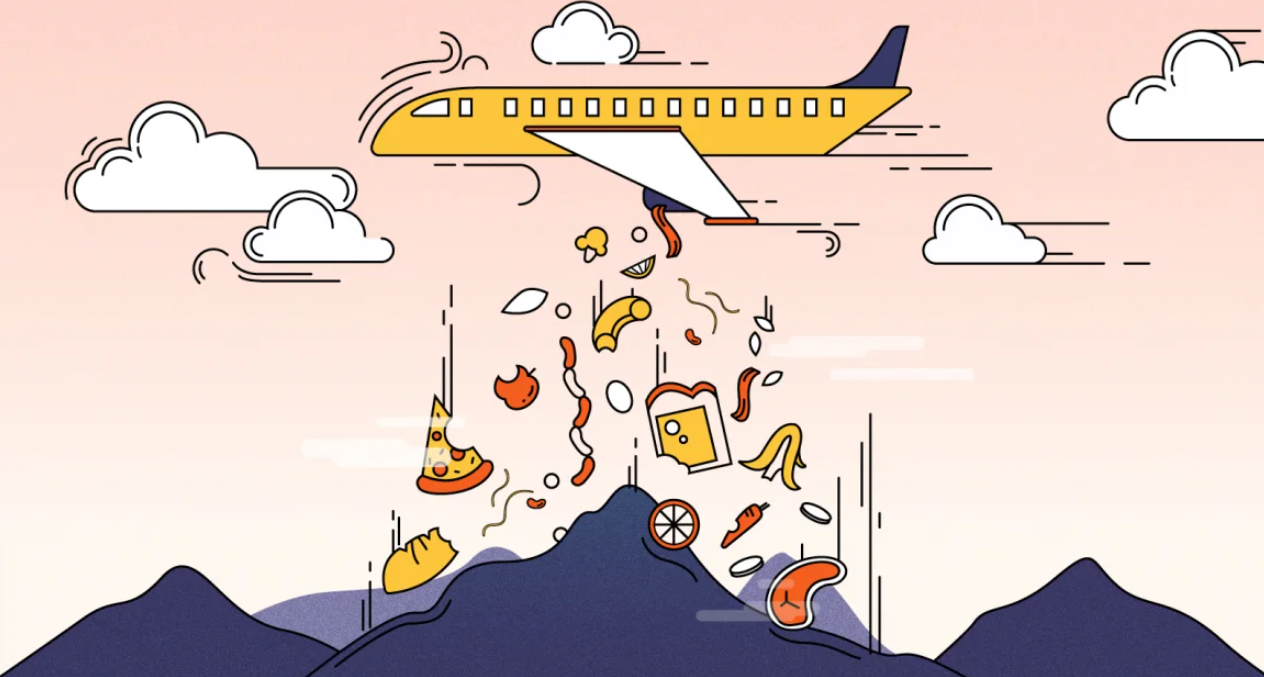
Illustration of waste
The aviation industry has its problems about environmental problems: fuel tankering has a devastating impact, and so does the pollution from jet air fuel. Airports are coming up with innovative solutions to become Carbon-neutral but the ghost of movements such as flyskam aka flight shaming and Tagskryt- train brag still haunts it. But there’s an everyday problem that the aviation industry should be dealing with much better: food waste.
Waste up high:
In total, 3.2 billion airline meals are produced annually, not including food sold at retail. However, a majority of the food and beverages are not consumed. 47.58% of the food waste produced was vegetable waste. The dinner-distributing process delivered the main measure of consumable waste. (Metawe Thamagasorn et al., 2019)
Emirates’ titanic cooking activity, producing 180,000 feasts every day for its gigantic flight organization, embodies the tremendous size of in-flight food creation. However, there is a hidden cost to this impressive feat: food waste. The issue can be seen at a microcosmic level by taking a single look at the packaging that has been discarded, leftover meals, and empty beverage containers.
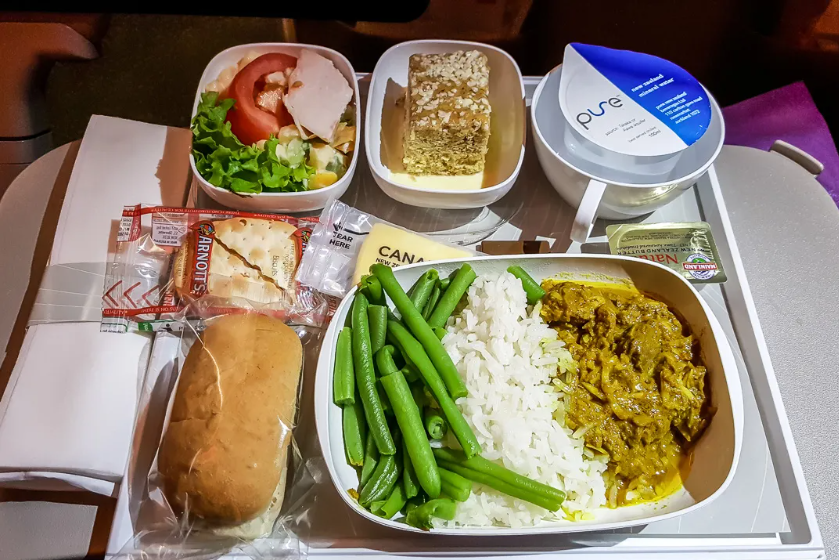

In 2017, the International Air Transport Association (IATA) discovered that in-flight catering resulted in the waste of 1.14 million metric tons of food, accounting for 25% of all cabin waste. Given that the market for inflight catering services was valued at approximately $15.5 billion that year, IATA estimates that up to $3.9 billion worth of food was either disposed of in landfills or incinerated. Zooming out, the picture becomes even more alarming. According to IATA, airlines produced a staggering 5.2 million metric tons of waste in the same year, with projections indicating that this number could double by 2030.
An average of 1.43 kilograms of waste, including waste from the toilet, is estimated to be produced per passenger. (Godson, 2014). Organic matter, along with paper, cardboard, and packaging, are the primary components of waste materials. (G. Blanca-Alcubilla et al., 2019).
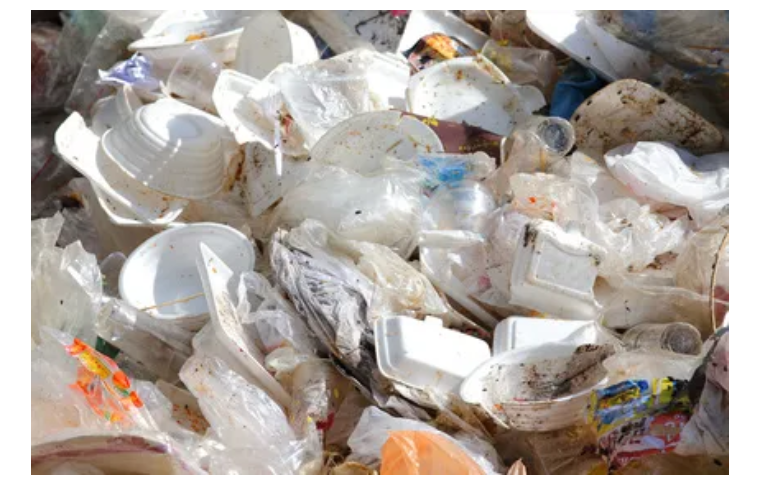

Waste from aeroplane
Maintaining food safety, hygiene, freshness, and weight minimization are two competing priorities for airlines. As a result, the cabin frequently uses a lot of plastic packaging. To ensure passenger satisfaction, airlines frequently err on the side of caution by stocking excess food on board. This tendency to overstock, driven by concerns about customer satisfaction, significantly contributes to the issue of food waste.
Combating food waste in the skies
In the Food Waste Index Report 2021, it is indicated that around 931 million metric tons of food, which is around 17% of the food that was sold to consumers in the year 2019, was dumped into the dustbins of households, retailers, restaurants, and other food services. So, we can say that about one-third, or about 30%, of the total food produced is wasted globally. Huge amounts of food are wasted through airplanes each year, with estimates suggesting millions of tons are wasted. They are too numerous to list, but one of the most impactful implications of the unfinished meals is that the aviation industry weighs on the environment. This is draining precious resources, and it also puts huge pressure on airlines from a business perspective by expending countless amounts of food that are then discarded.


Food waste
The uplifting news? This issue must have different arrangements. However, it should be noted that the present paper is focused on asynchronous learning only. The efficiency of the method is that by ensuring the proper and no-waste feeding of passengers, the airlines will achieve large-scale food waste reductions and improved sustainability. How do I do it? Travelers can predict the demand, and airlines are equally able to avoid cases where they offer more products than necessary.
Calculating daily consumption can help evaluate portion sizes and possible ways to eliminate unappreciated menu items. Flexible packaging solutions incorporate the use of certain modern techniques, such as vacuum packing or serving in a specific measured portion, to enhance their durability to a certain extent and reduce waste. Some measures that airlines can take include partnering with food banks or charities to make donations of the serving foods that are still safe for consumption since they have not yet reached their expiration.
Furthermore, there should be suggestions concerning waste food through waste-to-energy research done regularly. These are some measures airlines can employ to improve their performance while lowering their environmental impact. Overall sustainability brings profitability to the processes because less food is wasted while preserving our planet.
Minimizing onboard trash
One of the biggest issues airlines are addressing to be more sustainable is onboard waste. The complete process of reducing waste and increasing efficiency.
Optimized Meal Planning and Portion Control
One important strategy is to make use of passenger data to understand and predict meal patterns and preferences. Using this predictive methodology, airlines can more accurately plan and produce meals, reducing waste. Using such a “crystal ball” method, meal provisioning becomes more closely in line with what passengers need, and less waste is generated. Adjusting portion sizes makes sure that food waste and resource usage also don’t continue, based on flight times and the types of passengers who will be on board, and then into effect. Applewood-smoked chicken for half the cabin, or 6-inch sandwiches instead of giant hoagies for shorter flights, cuts uneaten meals by as much as half.
Sustainable Packaging Solutions
Another is the complete ban on the use of single-use plastics because they have devastating consequences for the environment. They can still replace it with such environment-friendly and biodegradable materials as green packing to cut through the litter output. Such services as disposable cutlery that can decompose through biodegradation, food trays that can turn into compost, and recyclable food packaging can help reduce food leftovers’ negative contribution to the environment. It also combines to solve the waste issue as well as use more of the desirable environmental sustainability objectives.
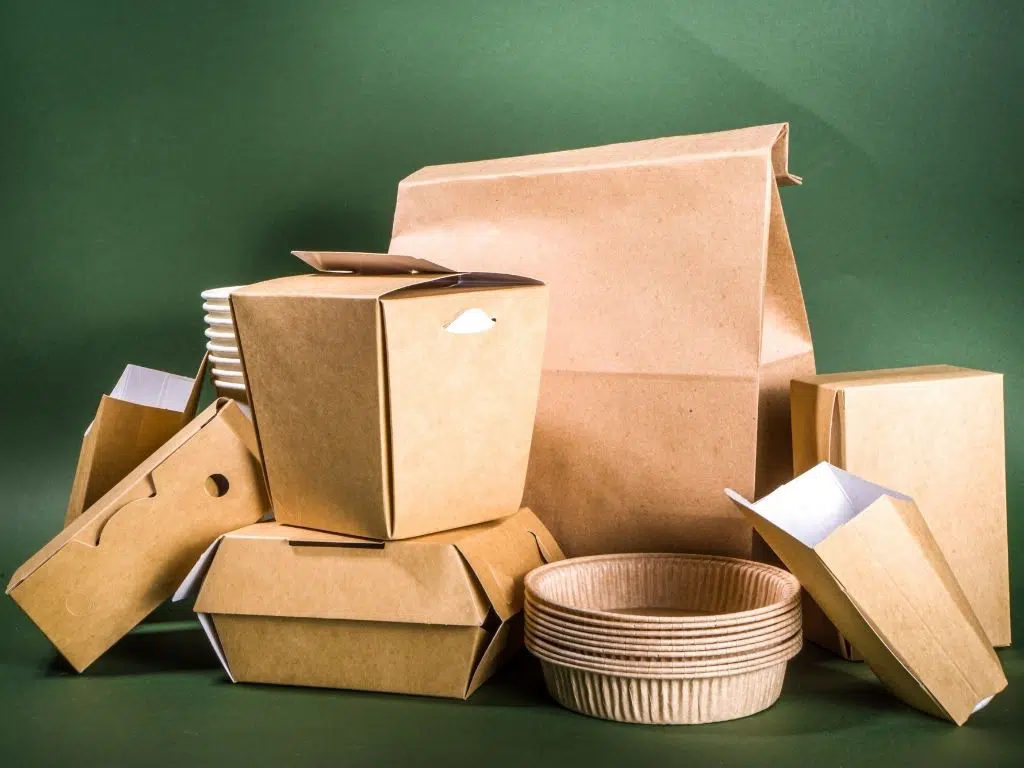

On-Demand Catering and Food Donation
The idea of giving passengers the ability to order food at any time is another innovation onboard. This means that the number of meals required can be prepared beforehand, reducing waste from excess meals that may not have been sold. Concerning passengers, this system can increase their satisfaction through a more individualized choice of meals. However, there are more effective ways of addressing the issue: donating untouched, surplus food to local food banks and charity organizations. Such collaborations can go a long way in helping to change what would otherwise be waste into important products for the needy.
Robust Recycling Programs
In addition, the adoption of sound recycling strategies when it comes to materials like plastics, glasses, and aluminum is crucial. In this way, an airline can dissociate these materials from the traditional wasteful route of being dumped into a landfill and recycle them instead. In addition to decreasing the amount of waste, it also helps to minimize the consumption of raw materials and energy usage. The overall recycling policy can involve having collection points on board and at terminals, thus ensuring that recyclable materials are processed accordingly.


Regular waste audits and staff training
Reporting waste generation is a good way to track areas that contribute most of the waste. Such knowledge allows airline operators to develop specific measures to improve the management of waste in the industry even more efficiently. A waste audit test can help in finding out that there is more work that could be done to properly manage waste. It is also therefore important to educate the airline staff, for example, the stewards and stewardesses, on ways to reduce waste and adopt sustainable practices. Employee education programs can instill a frame of reference for environmentally friendly practices and ensure that people under their instruction take the same attitude towards the environment regardless of their place of work.
Community and Industry Collaboration
This means that through sustainable cooperation with various organizations, such as environmental organizations and other stakeholders, the operations of airline companies can be taken to the next level in terms of sustainability. Cooperating with competitors on recycling programs may bring about common practices as well as ideas that have not been considered or developed in isolation. The impact of using awareness campaigns to mobilize passengers for sustainability initiatives can also be boosted by repeatedly motivating passengers to practice waste reduction when traveling.
In summary, airlines are actively working towards a more sustainable future by adopting a multi-faceted approach to minimize onboard waste. Through optimized meal planning, sustainable packaging, on-demand catering, robust recycling programs, regular waste audits, staff training, and community collaboration, airlines can significantly reduce their environmental footprint while enhancing operational efficiency and passenger satisfaction.
What is being done right now?
On World Food Day 2020, Emirates Flight Cooking (EKFC) swore to diminish food squandering by 35% across its focal tasks in Dubai. KFC’s commitment is a significant step toward sustainability in the aviation catering industry, capable of preparing up to 225,000 meals per day at peak capacity and serving over 100 airlines. EKFC and Winnow have collaborated to implement a cutting-edge AI and machine-learning food waste management system to reach this lofty goal. Smart scales and a camera are used in this innovative system to automatically identify and monitor various types of food waste. By perceiving and arranging the food being disposed of, the framework computes both the monetary and ecological expenses, permitting EKFC to enhance its buying choices and diminish squandering all the more.
Etihad Aviation routes are following uneaten economy-class feasts. It has collaborated with Lumitics to test the application of machine learning and computer vision to reduce food waste on its flights. Based on the design of the meal foils, the technology distinguishes and identifies the types and quantities of unfinished meals without the need for human intervention. This enables Etihad to track unfinished food when an aircraft lands at an airport.
Japan Airlines (JAL) has implemented both strategies to avoid food waste while on a flight. Passenger Choice: Their website now allows passengers on selected flights to forfeit meal services at least a day before the service. This helps in decreasing the frequency with which the meals are prepared, thus reducing the amount of food that is likely to remain uneaten. Composting Leftovers: Previously, their inflight catering subsidiary, JAL Royal Catering, only began composting in 2009. Earlier, they produced about 150 tons of food waste in 2019, and they were producing more than 11 tons of compost in the first quarter of this year alone. This year, they plan to reach at least 95% composting of food preparation leftovers at airports in Tokyo’s Narita and Haneda. undefined This combined approach shows that JAL is keen on practicing sustainable management because, on one hand, it deals with the issue of food waste at the root cause level, that is, at the passenger level, and on the other hand, where potential food waste is unavoidable, it disposes of the leftovers in an environmentally friendly manner by composting them.
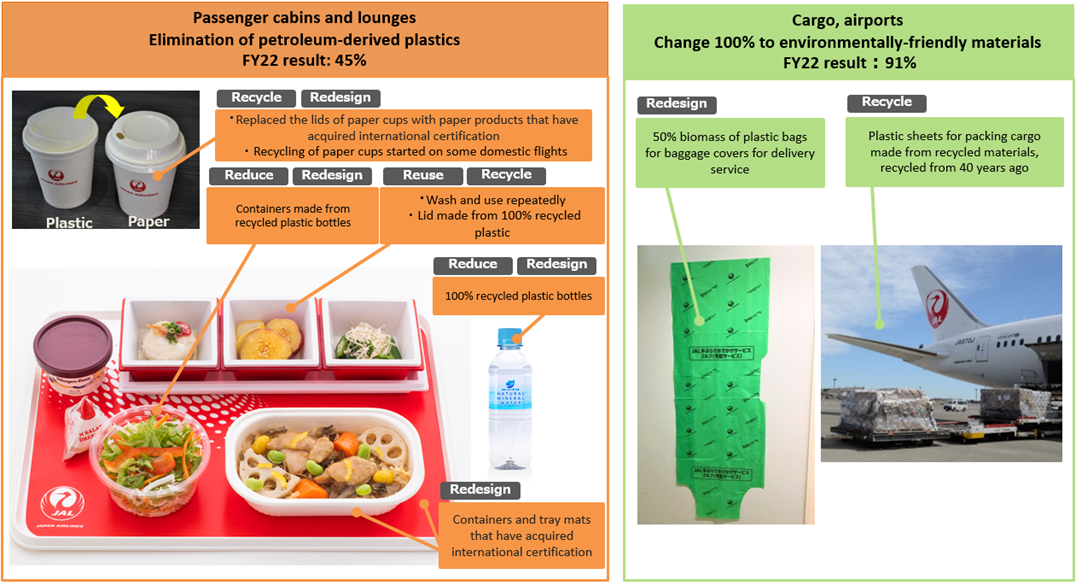

Airline companies have received good and interesting opportunities for selling things to passengers on flights, but all these systems can be useful for the environment. This year, a company known as Gate Group decided to partner with Black Swan, a company that specializes in data analysis, to apply their Epax system to easyJet flights. Epax also applies technology where instead of an A4 paper being provided to order food and other things, they use phones. It is as simple as getting on the airplane, accessing our plane wifi, and engaging in shopping right from your browser.
Conclusion: Toward a Sustainable Future in Aviation Catering
The aviation industry’s problem of food waste is still enormous; apart from costing a lot of money, it will also cause pollution. This madness translates into 3.2 billion airline meals consumed every year, leaving a wake of environmental degradation in its wake. However, airlines have become conscious of this problem, and they are in the process of searching for new ways that will contribute to the solution of this problem and make the influence less harmful. Emirates Flight Catering (EKFC) has moved a notch up to ensure that it cuts its food waste by one-third, largely due to the integration of new AI and machine learning supported by Winnow. This system helps identify and track food waste, allowing EKFC to maintain a comprehensive understanding of the amount wasted and make properly informed decisions regarding purchasing to minimize waste.


Other airlines, including Etihad Airways as well as Japan Airlines (JAL), are also making corresponding efforts. Machine learning and computer vision tools are used to control and monitor the leftovers from Etihad’s meals, just as JAL provides passengers with the option of opting out of the meal provision, and the company has fully embraced composting. However, the best practices include meal planning, portion control, and packaging, and these go hand in hand with practicing sustainable catering. The roles of passengers are not limited to just traveling but also being a source of information regarding their eating habits to avoid food waste by airlines. The packaging of products and products themselves have been shifted towards more sustainable one-time-use options instead of plastics, and most businesses are providing food only when it is asked to avoid overproduction.
Other measures include partnerships with food banks and charities to organize food donations, rigorously followed recycling practices, and consistent waste assessments for further enhancement of these programs. Staff training and involvement, as well as explaining to passengers the principles of waste management, constitute an essential part of the general strategy.
In conclusion, it is imperative to acknowledge that the aviation industry has a long way to go in terms of managing food waste, yet the steps being taken confirm that everyone wants a sustainable future. Here, Or has pinpointed feasible technological and managerial solutions that can help airlines decrease negative impacts on the environment by embracing new technologies and strategic partnerships.
Resources:
- Metawe Thamagasorn, Chanathip Pharino, An analysis of food waste from a flight catering business for sustainable food waste management: A case study of halal food production process, Journal of Cleaner Production, Volume 228, 2019.
- G. Blanca-Alcubilla, M. Roca, A. Bala, N. Sanz, N. De Castro, P. Fullana-i-Palmer, Airplane cabin waste characterization: Knowing the waste for sustainable management and future recommendations, Waste Management, Volume 96, 2019.
- Li, Xiang-Dong & Poon, Chi Sun & Lee, Shuncheng & Chung, Shan & Luk, F, Waste reduction and recycling strategies for the in-flight services in the airline industry. Resources, Conservation and Recycling, 2003.
